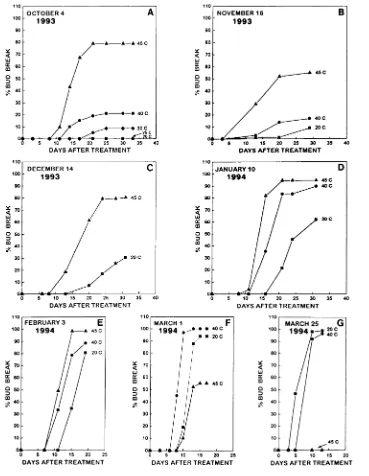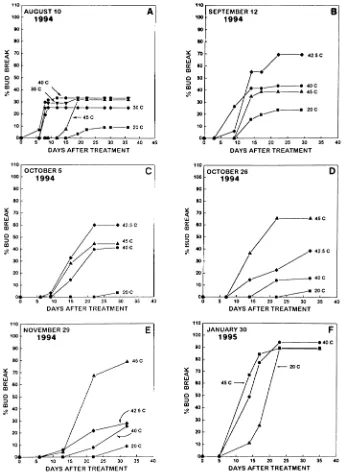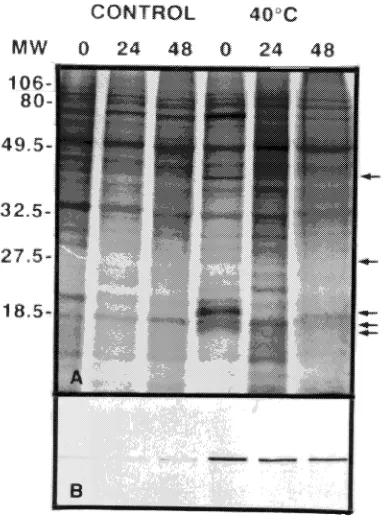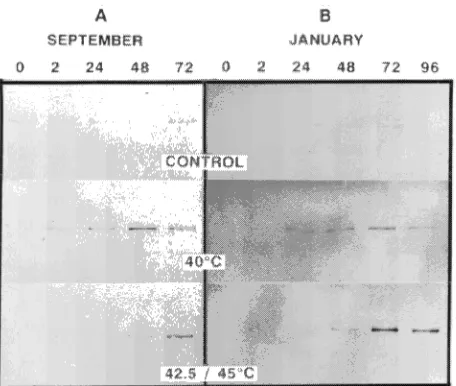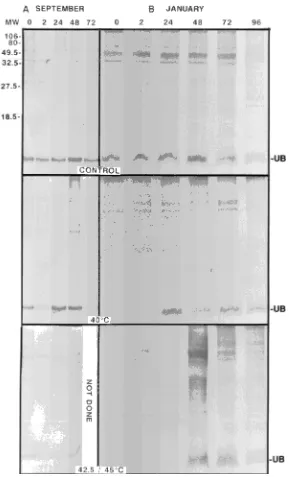Summary We assessed the effects of near-lethal heat stress on bud break, heat-shock proteins (HSPs) and ubiquitin in hybrid poplar (Populus nigra (L.) Charkowiensis ×P. nigra (L.) incrassata). Shoots, with 10--15 buds each, were collected from September to March and exposed to temperatures between 20 and 60 °C for 2 h. Shoots were then placed in a greenhouse at 18--22 °C with supplemental light and cumulative bud break was recorded over a 4-week period. Samples of bud tissues were collected during and up to 96 h after heat treatment for protein analysis. De novo synthesis of proteins was monitored by exposing excised buds to [35S]-methionine for 3 h before,
during, or after heat treatment. Heat treatments of 40--45 °C resulted in both a release from endodormancy and a decrease in thermal units needed for bud break during ecodormancy. The response to near-lethal heat stress was complex and was af-fected by intrinsic thermal sensitivity. Heat treatments were least effective during August and became progressively more effective as endodormancy progressed. In the later stages of ecodormancy, a heat treatment of 45 °C either inhibited bud break or killed the buds. Although temperatures of 42.5 to 45 °C inhibited incorporation of [35S]-methionine into proteins
for at least 48 h, several HSPs were synthesized in response to temperatures of 40--45 °C. Immunoblots indicated that one of the heat-induced proteins was immunologically related to HSP70. Increases in free and conjugated forms of ubiquitin were also observed in response to heat treatment. Production of HSPs and ubiquitin, however, was not consistently associ-ated with the heat treatments that induced the highest percent-age of bud break. The roles of heat-induced protein degradation, HSPs, and ubiquitin in overcoming dormancy by near-lethal heat stress are discussed.
Keywords: bud dormancy, ecodormancy, endodormancy, near-lethal stress, woody plants.
Introduction
In response to seasonal changes in environmental conditions, temperate woody plants have evolved a capacity for seasonal
dormancy during which growth is inhibited or arrested (Samish 1954, Lang 1994). Dormancy is also believed to be a necessary prerequisite for achieving maximum cold hardiness (Weiser 1970, Levitt 1980, Sakai and Larcher 1987). A variety of near-lethal stresses are capable of abruptly releasing buds of woody plants from dormancy (Fuchigami and Nee 1987). In particular, near-lethal heat stress is effective in releasing buds of woody plants from dormancy (Wang and Faust 1994, Shi-razi and Fuchigami 1995, Wisniewski et al. 1996b). Shirazi and Fuchigami (1993) suggested that stresses in general may be universally involved in the breaking of bud dormancy and that the impact of near-lethal stresses on bud dormancy may explain why chilling models used to predict the development of bud dormancy do not work satisfactorily in some environ-ments.
The mechanism by which a short exposure to a variety of near-lethal stresses overrides intrinsic locks on growth and development is poorly understood. Exposure to near-lethal stresses results in an increase in electrolyte leakage from ex-posed tissues (Shirazi and Fuchigami 1993, Wisniewski et al. 1996b) and an increase in antioxidants (Fuchigami and Nee 1987, Siller-Cepeda et al. 1992, Shirazi et al. 1994, Wang and Faust 1994). The work of Fuchigami and Nee (1987) and Wang and Faust (1994) indicates that release from bud dormancy by near-lethal stresses, such as cold, heat, and allyl disulfide, is associated with the removal of free radicals through activated peroxide-scavenging systems.
Exposure to high temperatures generally results in an inhi-bition of normal protein synthesis and an increase in the translation of mRNAs for heat shock proteins (HSPs) (Gurley and Key 1991). Increased degradation of proteins in response to heat shock is also common although the mechanism has not been well characterized (Ferguson et al. 1994). A small polypeptide, ubiquitin, is important in controlling protein turn-over in animals (Hershko and Ciechanturn-over 1992) and plants (Vierstra 1993). Ubiquitin is also heat inducible but its role in heat-induced protein degradation is unclear (Ferguson et al. 1994). Wisniewski et al. (1996b) postulated that heat-induced denaturation of regulatory proteins controlling dormancy may
Effects of near-lethal heat stress on bud break, heat-shock proteins and
ubiquitin in dormant poplar (
Populus nigra Charkowiensis
×
P. nigra
incrassata
)
MICHAEL WISNIEWSKI,
1JÖRG SAUTER,
2LES FUCHIGAMI
3and VALERIE STEPIEN
2 1USDA-ARS, 45 Wiltshire Road, Kearneysville, WV 25430, USA
2
Botanisches Institut, Christian Albrecht Universität, D-24098 Kiel, Germany
3
Department of Horticulture, Oregon State University, Corvallis, OR 97331, USA
Received May 28, 1996
lead to the removal of intrinsic blocks preventing the growth of buds.
We have characterized the ability of near-lethal heat stress to overcome bud dormancy in hybrid poplar (Populus nigra (L.) Charkowiensis ×P. nigra (L.) incrassata) and examined the effects of this stress on the induction of HSPs and ubiquitin to test the hypothesis that the synthesis of these proteins is associated with the release of buds from dormancy.
Materials and methods
Effect of heat-stress treatments on bud break
Terminal shoots (6--8 per treatment) of hybrid poplar (Populus nigra Charkowiensis × P. nigra incrassata) having approxi-mately 10--15 buds per twig were placed in perforated, heat-sealed, plastic bags. Heat was applied by submerging the bags in a constant temperature water bath set at a specific tempera-ture (20--60 ± 0.1 °C) for 2 h. Control shoots were also immersed in a waterbath for 2 h at ambient temperatures (about 20 °C) to eliminate the possibility that the heat effect was due solely to saturation of tissues with water. Following heat treat-ment, twigs were placed in Erlenmeyer flasks containing deionized water and placed in a greenhouse at 18--22 °C in a 16-h photoperiod with natural light supplemented and ex-tended by means of high pressure sodium lamps (250 µmol m−2 s−1) from 0600--1200 h. Bud break was recorded as a
cumulative percentage of bud break over a 4-week period. Approximately 50--60 buds were monitored for each treat-ment. Preliminary experiments indicated that significantly more buds were released from dormancy when the heat treat-ments were carried out on shoots enclosed in perforated bags than in waterproof bags (data not presented).
Electrolyte leakage
Electrical conductivity was measured as described by Arora et al. (1992) and Wisniewski and Arora (1993). There were five replicates for each treatment. For each temperature, three buds were halved longitudinally and placed in 7 ml of deionized water. The buds were vacuum infiltrated and then placed on a gyratory shaker for 2 h at 200 rpm. Conductivity of the effusate was measured with a conductivity meter (YSI Model 35, Yellow Springs Instruments, Yellow Springs, OH). Test tubes containing the buds were then autoclaved, returned to the shaker for 2 h and the conductivity of the effusate was re-meas-ured. Data are presented as the mean percentage electrical conductivity compared to total conductivity obtained from the autoclaved buds.
In vivo labeling with [35S]-methionine
Controls and heat-treated vegetative buds of hybrid poplar were excised from twigs immediately following the 2-h tem-perature treatments (time 0) and 2, 24, 48, 72, and 96 h after the treatments. Approximately 10 buds were sampled from each temperature treatment. Five µl of borate buffer (50 mM borate plus 50 mM ascorbic acid, pH 9.0) was placed on the base of each bud to prevent desiccation. Each bud was inverted
and placed in a well of a microtiter plate. The borate buffer was removed from the bottom of each inverted bud and replaced with 0.5 µl of [35S]-methionine (1.83 × 105 Bq; DuPont,
Wil-mington, DE). Buds were then placed in a high humidity chamber and incubated at room temperature for 3 h. Following incubation, buds were washed three times with borate buffer containing 5 mM methionine, frozen in liquid nitrogen and stored at --80 °C until analyzed.
Frozen buds were ground in liquid nitrogen in a mortar with a pestle. The powder was transferred to a microcentrifuge tube and 600 µl of borate buffer containing 1% (v/v) 2-mercap-toethanol and 1 mM phenylmethylsulfonyl fluoride. Tubes were vortexed and then sonicated for 3 min. The samples were centrifuged for 30 min at 4 °C at 15000 g. Protein content of the supernatants was measured by a modified Bradford assay (Ramagl and Rodriguez 1985). Equal amounts of protein were then precipated from the supernatants with 10% (v/v) trichlo-roacetic acid, rinsed several times with acetone and the result-ing pellets were dissolved in sodium dodecyl sulfate gel electrophoresis (SDS-PAGE) sample buffer (Laemmli 1970). Discontinuous SDS-PAGE on 12.5% polyacrylamide was car-ried out as previously described (Arora and Wisniewski 1994) using a PROTEAN II electrophoresis unit (Bio-Rad, La Jolla, CA). Completed gels were exposed to X-ray film (Kodak, Rochester, NY) for 7--14 days at −80 °C to generate the autoradiograms.
Immunoblots
Six µg of protein extracted from unlabeled bud tissue from each sample was separated by SDS-PAGE. Subsequently, un-stained gels were electroblotted onto 0.45-µm nitrocellulose membranes (Schleicher and Schuell, Keene, NH) by means of a Bio-Rad mini trans-blot electrophoretic transfer cell (Arora and Wisniewski 1994). Blots were blocked in 1% (w/v) BSA and probed with either monoclonal HSP70 antibody (Sigma, St. Louis, MO) or polyclonal ubiquitin antibody (Sigma). Proteins for the ubiquitin studies were separated on 15% polyacrylamide gels. Immunoreactive bands were detected by alkaline phosphatase assay with a ProtoBlot Western Blot AP kit (Promega, Madison, WI).
Results
Effect of heat-stress treatments on bud break
Generally, the ability of near-lethal heat stress to overcome dormancy was time (stage of dormancy) and temperature de-pendent (Figures 1 and 2). In October 1993, no bud break occurred when shoots were treated at 20 or 25 °C, but percent-age of bud break increased from 10 to 79% as the temperature of the heat-stress treatments increased from 30 to 45 °C (Fig-ure 1A). Temperat(Fig-ures of 50 °C and above were lethal (data not shown). Poplar shoots collected in November 1993 and ex-posed to 45 °C had a lower percentage of bud break than similarly treated shoots collected in October 1993 (59 versus 79%, respectively), but the percentage of bud break was still sixfold higher than in the controls and threefold higher than in shoots in the 40 °C treatment (Figure 1B).
In December 1993, bud break was 80% in shoots in the 45 °C treatment compared to 33% in the controls; no 40 °C treatment was applied. In January 1994, bud break was 90--100% in shoots in the 40--45 °C treatments and 60% in the controls (Figure 1D). The high percentage bud break in the controls indicated that the buds were no longer endodormant. The percentage of bud break continued to increase in the control samples during February and was similar to that of shoots in the 40 °C treatment by March 1994 (Figures 1E--G). In early March 1994, bud break of shoots exposed to 45 °C was 55%, or about half of the percentage bud break observed in shoots in the control or 40 °C treatments (Figure 1F). By late March 1994, exposure of shoots to 45 °C resulted in inhibition
of bud break and high bud mortality indicating that the buds had undergone a distinct shift in thermotolerance.
Data obtained during the 1994--95 dormant season were similar to those obtained during the 1993--94 dormant season (cf. Figures 1 and 2). Heat treatments ranging from 30 to 45 °C were least effective in breaking dormancy during parador-mancy (August: 35% bud break) but their efficacy increased during subsequent months. By the end of November, 45 °C treatment resulted in 79% bud break. During endodormancy, the temperature that was most effective in inducing bud break changed from 42.5 to 45 °C (Figures 2A--E). By late January 1995, percentage bud break was similar in shoots in all treat-ments after 20 days, although, as in the previous year, exposure
to 40 and 45 °C resulted in increased rates of bud break (Figure 2F).
Electrolyte leakage
In October 1993, exposure to 40, 45 and 50 °C increased conductivity by 5, 13 and 50%, respectively, over that of the 20 °C controls (data not shown). During the second dormant season, electrolyte leakage decreased in all treatments as the dormant season progressed, indicating an increase in thermo-tolerance of the buds (Table 1).
Effect of near-lethal heat stress on protein synthesis
In March 1994, several HSPs were induced in response to the 40 °C treatment (Figure 3A). Autoradiograms indicated that
Figure 2. Cumulative percentage of bud break in hybrid poplar from August 1994 until January 1995 following exposure to near-lethal heat stress. Sample size for each treatment was 50--60 buds and the 20 °C treatment served as the control.
Table 1. Electrical conductivity of buds after immersion in a water bath for 2 h at selected temperatures. Results are expressed as percent electrical conductivity compared to total conductivity of autoclaved buds (mean ± SD, n = 5).
Treatment temperature (°C)
Date 20 40 45
Oct 19, 1994 13 ± 1 19 ± 1 33 ± 5
Nov 16, 1994 9 ± 1 13 ± 1 22 ± 3
Dec 14, 1994 8 ± 1 --1 14 ± 4
1 Data not collected.
several low molecular mass HSPs and a 40-kDa protein were induced immediately after heat treatment, but were no longer present 24 h after heat treament. In contrast, HSP70 was induced immediately following the 40 °C heat treatment and the amount remained elevated for up to 48 h, after which the experiment was terminated (Figure 3B). It is not known whether the continued presence of high amounts of HSP70 was due to continued synthesis or lack of turnover. The induc-tion of HSPs in response to the 40 °C treatment was associated with earlier bud break compared to the controls (20 °C treat-ment) but not with a significantly higher percentage of total bud break (Figure 1F).
In September 1994, both high and low molecular mass HSPs were induced in response to the 40 °C treatment, but the induction was not apparent after 24 h (Figure 4A). In contrast, the 42.5 °C treatment resulted in a total inhibition of protein synthesis for at least 24 h and this was followed by a return to a normal pattern of protein synthesis. Autoradiograms of the January 1995 samples indicated a partial or complete inhibi-tion of protein synthesis during the first 2 h following exposure to 40 and 45 °C (Figure 4B). A 40-kDa protein was the major protein synthesized during the first 2 h following the 40 °C
treatment, but synthesis of this protein, which was also initially present in the controls, ceased after 24 h. By 72 h, the pattern of protein synthesis in the 40 °C treated samples was similar to that in the 20 °C control samples. Protein synthesis recovered within 24 h following the 45 °C treatment at which time the 40-kDa protein was the major protein synthesized; however, synthesis of the 40-kDa protein was greatly decreased by 48 h. After 48 h, patterns of protein synthesis were similar in sam-ples from all three treatments.
Immunoblots of the September samples indicated a gradual increase in HSP70 over a 48-h period following the 40 °C treatment and a gradual increase after 48--72 h in response to the 42.5 °C treatment (Figure 5A). Immunoblots probed with anti-ubiquitin showed increases in both free ubiquitin and high-molecular mass forms of conjugated ubiquitin (seen as
Figure 3. Synthesis of heat-shock proteins in buds of hybrid poplar following a 2-h exposure to either 20 (control) or 40 °C. Samples were collected in March 1994. Each bud (10 buds per treatment) was labeled with 1.83 × 105 Bq of [35S]-methionine for 3 h before protein
extrac-tion. Labeling was conducted immediately following the heat treat-ment (time 0) and 24 and 48 h after the heat treattreat-ment. A: Autoradiogram showing synthesis of several low molecular weight HSPs (arrows) immediately following heat treatment. B: Immunoblot probed with HSP70 antibody showing elevated amounts of HSP70 for at least 48 h following heat treatment.
dark smearing in the upper portion of the gel lane; Figure 6A) 48 h after the 40 and 42.5 °C treatments. No association between induction of HSPs and percentage bud break was evident. Among treatments, bud break occurred earliest in shoots in the 40 °C treatment (which also resulted in induction of HSPs); however, the greatest percentage of bud break oc-curred in response to the 42.5 °C treatment (Figure 2B), which shut down protein synthesis for 24 h and did not result in the induction of HSPs other than HSP70.
Immunoblots of January samples indicated similar patterns of induction of HSP70 in response to the three treatments as the September samples (Figure 5B). Anti-ubiquitin im-munoblots showed a decrease in ubiquitin during the first 2 h after exposure to the 40 °C treatment compared to amounts present in the controls (20 °C). Free ubiquitin was not detect-able in samples from the 45 °C treatment for the first 24 h after exposure; however, there were marked increases in both free and conjugated forms of ubiquitin at 48 h.
Discussion
Near-lethal heat treatments were capable of breaking endodor-mancy in poplar (Figure 1A--C). Similar observations have been made by Shirazi and Fuchigami (1995) in red-osier dog-wood (Cornus sericea L.) and by Wang and Faust (1994), who demonstrated that both high temperatures (40--45 °C) and sulfur-containing compounds (e.g., allyl disulfide) could over-come dormancy in apple (Malus domestica cv. Anna). Addi-tionally, the heat treatments increased the percentage or rate of bud break, or both, during ecodormancy (Figures 1D--F). Ap-parently, heat treatments can either reduce the number of thermal units necessary for bud break during ecodormancy or increase the effective temperature range for thermal unit accu-mulation. These changes were greater than the decrease in
thermal time needed to cause bud break that can be brought about by natural exposure to chilling temperatures (Murray et al. 1989, Heide 1993).
Thermotolerance increased during endodormancy (Octo-ber--January) and then decreased during the latter part of eco-dormancy (March) and these changes were reflected in the patterns of heat-treatment-induced bud mortality (Figures 1F and 1G) and electrolyte leakage (Table 1). The basis for the increase in thermotolerance is not known. Guy (1990) postu-lated that the accumulation of cold-induced, stress-repostu-lated pro-teins plays a role. Robertson et al. (1994) reported the presence of proteins in cold-acclimated cells suspension cultures of bromegrass (Bromus inermis Leyss) that conferred heat stabil-ity to extracts of total proteins from the cell cultures. Seasonal accumulation of dehydrin, a stress-related protein, has been reported in poplar and other species of woody plants (Wis-niewski et al. 1996a). In contrast to vegetative buds, Burr et al. (1993) found that the relationship between thermotolerance and dormancy in conifer needles was species specific, with the greater thermotolerance being observed in mature needles from actively growing plants than in needles from dormant, cold-hardy plants.
The HSPs are believed to play a role in the acquisition of thermotolerance (Vierling 1991, Howarth and Ougham 1993). Ubiquitin is also a heat-inducible protein and is believed to play a major role in tagging proteins for proteolysis (Hershko and Ciechanover 1992, Vierstra 1993). Ferguson et al. (1994) have suggested that ubiquitin may also have a protective func-tion as postulated for HSPs.
We found that HSPs and other heat-inducible proteins of varying molecular masses were induced in dormant buds of poplar in response to heat treatments. Putative HSPs belonging to the low and HSP70 group were induced in all of the experi-ments, whereas proteins having a similar molecular mass range to the high molecular weight HSPs were induced only in experiments conducted in September (Figure 4A). Except for HSP70, which was identified using a monoclonal antibody, none of the other putative HSPs were characterized. The induc-tion of a wide range of HSPs has been reported in Pinus and Picea seedlings (Gifford and Taleisnik 1994) as well as in callus tissue of Salix (Valhala et al. 1990). In January samples, expression of a heat-inducible 40-kDa protein was observed in control samples exposed to 20 °C. Synthesis of HSPs at normal growth temperatures has also been reported in Salix (Valhala et al. 1990) and was suggested to be an ecological adaptation to climates that exhibit large (50--60 °C) air temperature fluc-tuations. The extent of total protein synthesis in September and January bud samples (Figure 4A versus Figure 4B) differed markedly.
Protein degradation plays a major role in controlling the amounts of many keys enzymes involved in maintaining cellu-lar homeostasis and regulating differentiation, growth, and adaptation to new environmental conditions (Vierstra 1987). Plant responses to heat include increases in binding of ubiquitin to high molecular weight conglomerates (Shi-mogawara and Muto 1989, Ferguson et al. 1990, Wettern et al. 1990) and both increases and decreases in the abundance of
Figure 5. Immunoblots (6 µg protein per lane) of hybrid poplar buds probed with HSP70 antibody. Samples were collected in September 1994 and January 1995 and exposed to 20 (controls), 40, 42.5, or 45 °C for 2 h.
ubiquitin transcripts (Christensen et al. 1992, Garbarino et al. 1992). Because the ubiquitin-mediated proteolytic pathway exhibits major activity during seed formation and germination of Lupinus alba L. (Ferreira et al. 1995), we postulated that ubiquitin facilitates heat-induced bud break.
Neither the ubiquitin response nor the early presence of HSPs was associated with the highest percentage of bud break. If breakdown of regulatory proteins controlling dormancy is necessary for bud break to occur, then the breakdown does not involve ubiquitin; however, it may occur through non-specific leakage from cells as suggested by the increases in electrolyte leakage. In a study of heat-induced proteolysis in cultured pear (Pyrus communis L.) cells, Ferguson et al. (1994) reported little change in ubiquitin conjugation or the accumulation of
ubiquitin transcripts and suggested that ubiquitin may have an HSP-like protective function. Perhaps the late (24--48 h) ap-pearance of ubiquitin and HSP70 indicates a role in protecting newly synthesized proteins.
In summary, near-lethal heat stress (40--45 °C) induced bud break in dormant poplar and increased the rate of bud break during ecodormancy, indicating that the effect of the heat treatments was dependent on the stage of dormancy. Tempera-tures that stimulated bud break in winter were lethal in early spring, reflecting changes in the thermotolerance of the buds. Although induction of different classes of HSPs in bud tissues were observed at different times of the year, the induction of HSPs and ubiquitin was not associated with the temperature that was most effective in inducing bud break. The use of
near-lethal heat stress may prove to be a useful technique for studying changes in proteins and gene regulation associated with the release of dormancy.
References
Arora, R. and M. Wisniewski. 1994. Cold acclimation in genetically related (sibling) deciduous and evergreen peach (Prunus persica L. Batsch). II. A 60-kilodalton bark protein in cold acclimated tissues of peach is heat stable and related to the dehydrin family of proteins. Plant Physiol. 105:95--101.
Arora, R., M. Wisniewski and R. Scorza. 1992. Cold acclimation in genetically related (sibling) deciduous and evergreen peach (Prunus persica L. Batsch). I. Seasonal changes in cold hardiness and polypeptides of bark and xylem tissues. Plant Physiol. 99:1562--1568.
Burr, K., S. Wallner and R.W. Tinus. 1993. Heat tolerance, cold hardiness, and bud dormancy relationships in seedlings of selected conifers. J. Am. Soc. Hortic. Sci. 118:840--844.
Christensen, A.H., D.R. Sharrock and P.H. Quail. 1992. Maize polyu-biquitin genes: structure, thermal perturbation of expression and transcript splicing, and promoter activity following transfer to pro-toplasts by electroporation. Plant Mol. Biol. 20:235--244. Ferguson, I.B., J.A. Guikema and G.M. Paulsen. 1990. Ubiquitin pool
modulation and protein degradation in wheat roots during high temperature stress. Plant Physiol. 92:740--746.
Ferguson, I.B., S. Lurie and J.H. Bowen. 1994. Protein synthesis and breakdown during heat shock of cultured pear cells. Plant Physiol. 104:1429--1437.
Ferreira, R.M.B., P.C.R. Ramos, E. Franco, C.P.P. Ricardo and A.R.N. Teixeira. 1995. Changes in ubiquitin and ubiquitin-protein conju-gates during seed formation and germination. J. Exp. Bot. 46:211--219.
Fuchigami, L.H. and C.C. Nee. 1987. Degree growth stage model and rest breaking mechanisms in temperate woody perennials. Hort-Science 22:836--845.
Garbarino, J.E., D.R. Rockhold and W.R. Belknap. 1992. Expression of stress-responsive ubiquitin genes in potato tubers. Plant Mol. Biol. 20:235--244.
Gifford, D.J. and E. Taleisnik. 1994. Heat-shock response of Pinus and Picea seedlings. Tree Physiol. 14:103--110.
Gurley, W.B. and J.L. Key. 1991. Transcriptional regulation of the heat-shock response: a plant perspective. Biochemistry 30:1--12. Guy, C.L. 1990. Cold acclimation and freezing stress tolerance: role
of protein metabolism. Annu. Rev. Plant Physiol. Plant Mol. Biol. 41:777--784.
Heide, O.M. 1993. Daylength and thermal time responses of budburst during dormancy release in some northern deciduous trees. Physiol. Plant. 88:537--540.
Hershko, A. and A. Ciechanover. 1992. The ubiquitin system for protein degradation. Annu. Rev. Biochem. 61:761--807.
Howarth, C.J. and H.J. Ougham. 1993. Gene expression under tem-perature stress. New Phytol. 125:1--26.
Laemmli, U.K. 1970. Cleavage of structural proteins during the as-sembly of the head of bacteriophage T4. Nature 227:680--685. Lang, G.A. 1994. Dormancy----the missing links: integrating
molecu-lar information into complex plant/environment systems. Hort-Science 29:1255--1263.
Levitt, J. 1980. Chilling, freezing, and high temperature stresses. In Responses of Plants to Environmental Stresses, 2nd Edn., Vol. 1. Academic Press, New York, NY, 497 p.
Murray, M.B., M.G.R. Cannell and R.I. Smith. 1989. Date of budburst of fifteen tree species in Britain following climatic warming. J. Appl. Ecol. 26:693--700.
Ramagl, L.S. and I.V. Rodriguez. 1985. Quantification of microgram amounts of protein in two-dimensional polyacrylimide gel electro-phoresis sample buffer. Electroelectro-phoresis 6:559--563.
Robertson, A.J., M.M. Ishhikawa, L.V. Gusta and S.L. Mackenzie. 1994. Abscisic acid-induced heat tolerance in Bromus inermis Leyss cell-suspension cultures----heat-stable, abscisic acid-respon-sive polypeptides in combination with sucrose confer enhanced thermostability. Plant Physiol. 105:181--190.
Sakai, A. and W. Larcher. 1987. Frost survival of plants: responses and adaptation to freezing stress. Springer-Verlag, Berlin, pp 97--105. Samish, R.M. 1954. Dormancy in woody plants. Annu. Rev. Plant
Physiol. 5:183--204.
Shimogawara, K. and S. Muto. 1989. Heat shock induced change in protein ubiquination in Chlamydomonas. Plant Cell Physiol. 30:9--16. Shirazi, A.M. and L.H. Fuchigami. 1993. Recovery of plants from
‘‘near-lethal’’ stress. Oecologia 93:429--434.
Shirazi, A.M. and L.H. Fuchigami. 1995. The relationship of ‘‘near-le-thal’’ stress on dormancy and stem cold hardiness in red-osier dogwood. Tree Physiol. 15:275--279.
Shirazi, A.M., J.H. Siller-Cepeda and L.H. Fuchigami. 1994. Role of glutathione in recovery of red-osier dogwood plants from near-le-thal heat stress. Can. J. For. Res. 24:415--418.
Siller-Cepeda, J.H., L.H. Fuchigami and T.H.H. Chen. 1992. Glu-tathione content in peach buds in relation to development and release of rest. Plant Cell Physiol. 33:867--872.
Valhala, T., T. Eriksson and P. Engström. 1990. Heat-shock proteins in willow (Salix viminalis). Physiol. Plant. 80:301--306.
Vierling, E. 1991. The roles of heat shock proteins in plants. Annu. Rev. Plant Physiol. Plant Mol. Biol. 42:579--620.
Vierstra, R.D. 1987. Ubiquitin, a key component in the degradation of plant proteins. Physiol. Plant. 70:103--106.
Vierstra, R.D. 1993. Protein degradation in plants. Annu. Rev. Plant Physiol. Plant Mol. Biol. 44:385--441.
Wang, S.Y. and M. Faust. 1994. Changes in the antioxidant system associated with bud break in ‘Anna’ apple (Malus domestica Borkh.) buds. J. Am. Soc. Hort. Sci. 119:735--741.
Weiser, C.J. 1970. Cold resistance and injury in woody plants. Science 169:1269--1277.
Wettern, M., H.A. Parag, L. Pollman, I. Ohad and R.G. Kulka. 1990. Ubiquitin in Chlamydomonas reinhardii. Distribution in the cell and effect of heat shock and photoinhibition on its conjugate pat-terns. Eur. J. Biochem. 191:571--576.
Wisniewski, M. and R. Arora. 1993. Adaptation and response of fruit trees to freezing temperatures. In Cytology, Histology, and Histo-chemistry of Fruit Tree Diseases. Ed. A.R. Biggs. CRC Press, Boca Raton, FL, pp 299--320.
Wisniewski, M., T.J. Close, T. Artlip and R. Arora. 1996a. Seasonal patterns of dehydrins and 70-kilodalton heat-shock proteins in bark tissues of eight species of woody plants. Physiol. Plant. 96:496--505. Wisniewski, M., L.H. Fuchigami, J.J. Sauter, A. Shirazi and L. Zhen. 1996b. Sublethal stress and bud dormancy in woody plants. In Plant Dormancy: Physiology, Biochemistry, and Molecular Biology. Ed. G.A. Lang. CAB International, Oxon, U.K., pp201--210.
